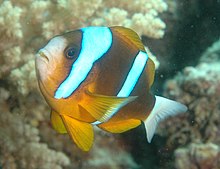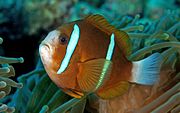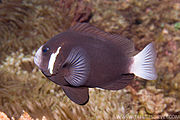Amphiprion akindynos
| Amphiprion akindynos | |
|---|---|

| |
| Scientific classification | |
| Domain: | Eukaryota |
| Kingdom: | Animalia |
| Phylum: | Chordata |
| Class: | Actinopterygii |
| Family: | Pomacentridae |
| Genus: | Amphiprion |
| Species: | A. akindynos
|
| Binomial name | |
| Amphiprion akindynos Allen, 1972
| |
Amphiprion akindynos, the Barrier Reef anemonefish, is a species of
Description
Adults are an orange-brown colour with two white bars with black edging encircling the body. The first bar is located on the head behind the eyes and may be thin and broken. The second bar is on the body below the
Colour variations
Some anemonefish species have colour variations based on geographic location, sex and host anemone. A. akindynos does not show any of these variations.[4]
Similar species
The white bars on A. akindynos are generally narrower than
-
A. akindynos (Barrier Reef anemonefish)
-
A. clarkii(Clark's anemonefish)
-
A. chrysopterus (Orange-fin anemonefish), Palau
-
The genetically related A. mccullochi
Distribution and habitat
The Barrier Reef anemonefish is found in
Host anemones
The relationship between anemonefish and their host sea anemones is not random and instead is highly nested in structure.[9] A. akindynos is a generalist, being hosted by the following 6 out of the 10 host anemones: [4][2][9]
- Entacmaea quadricolor Bubble-tip anemone
- Heteractis aurora beaded sea anemone
- Heteractis crispa Sebae anemone
- Heteractis magnifica magnificent sea anemone
- Stichodactyla haddoni
- Stichodactyla mertensii Mertens' carpet sea anemone
Reproduction
The Barrier Reef anemonefish is a nesting fish. A few days before mating, aggression from the dominant male towards the female increases, and at the same time he begins clearing a nest site, usually on a rock close to the host anemone. The rock is cleaned of algae, sometimes with the assistance of the female. When spawning takes place the female zig-zags over the nest site and the male follows fertilizing the eggs which have been deposited. Between 100 and 1000 elliptical eggs of between 3 and 4 mm in length may be laid. They are attached to the nest site by a mass of short filaments. The male guards and aerates the eggs for 6 to 7 days until they hatch.[2] The larvae are then dispersed by currents and swimming. Larvae mortality is high, with most of the surviving larvae settling on the original reef.
Diet
The diet of the Barrier Reef anemonefish consists primarily of algae (seaweeds) and zooplankton.[10] The dominant pair in the social hierarchy tend to travel farther from the host anemone in order to find food. The host anemone may benefit from small pieces of food which the anemonefish drop when feeding.
Conservation status
Anemonefish and their host anemones are found on coral reefs and face similar
Aquatic emblem
The Barrier Reef anemonefish was officially named as the state aquatic emblem of Queensland in March, 2005.[13]. The idea to identify an Aquatic Emblem originated from Dr Adam Smith and the Australian Underwater Federation, the peak group representing divers [14]
References
- .
- ^ a b c d Bray, Dianne. "Barrier Reef Anemonefish, Amphiprion akindynos". Fishes of Australia. Archived from the original on 24 September 2015. Retrieved 24 August 2014.
- PMID 15252999.
- ^ ISBN 9780730983651. Archived from the originalon 18 October 2014.
- PMID 23122007.
- ^ DeAngelis, R. "What we really know about the diversity of Clownfish". Archived from the original on 25 September 2015. Retrieved 20 September 2015.
- PMID 22957165.
- S2CID 253813305.
- ^ PMID 17476781.
- ISBN 978-0-7641-3256-8.
What does it eat? In the wild, zooplankton and occasionally seaweeds.
- ^ S2CID 255575307.
- ^ .
- ^ "Qld aquatic emblem". Queensland Government. Retrieved 2 October 2010.
- ^ "Australian Underwater Federation (2004) Anemonefish To Be Queensland's Aquatic Emblem". 23 November 2004.
External links
- "Amphiprion akindynos". Integrated Taxonomic Information System. Retrieved 30 January 2006.
- Amphiprion akindynos. Allen, 1972. Retrieved through: World Register of Marine Species.
- Froese, Rainer; Pauly, Daniel (eds.) (2014). "Amphiprion akindynos" in FishBase. November 2014 version.
- "Amphiprion akindynos (barrier reef anemonefish)". University of Michigan Museum of Zoology. 1995. Archived from the original on 4 February 2007. Retrieved 11 January 2007.





